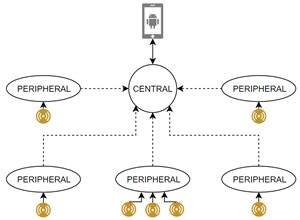Hello,
I am in the process of determining a system architecture for a sensor-bluetooth-android application. The goal is to read sensor information from an Android device, using ble and several sensors as the embedded part of the project.
The sensors will be connected to nrf52832 modules. Various elements will be measured so the communication between sensors and ble modules will be in several ways (SPI, I2C, analog readings).
As of right now, there is a working setup where several sensors are attached to a nrf52 module and their readings are transmitted through advertising packets to the Android application The limitation of this way is the number of bytes that can be sent per advertisement and attaching several sensors to one small battery is resource hungry and will not satisfy the capacity vs. time requirements.
I have been thinking of doing it like on the attached image:

In this way, the sensors could be powered from different coin cell batteries of their peripherals. The peripherals would send their data to the central BLE node and that node will be set up to have a connection with the Android device.
- Is this possible to do and which examples should I look into?
- How should peripherals talk to the central? Should they be connected, or do some kind of directed advertising?
- What would be the limitations of the data transmission between the central and android device? I have came to understand that the advertising package is limited to 31 bytes (usable is 20 something). How limited would it be to transmit data in such way?
- Would it be possible to send a command to the central to put all devices to sleep, until connection is initiated again?
- It would be possible to set-up all peripherals as advertisers and filter the results on the android phone - what do you think about that?
I will be grateful if you could offer some useful links and thoughts about the idea - especially keywords and topics what I should research according to the latest capabilities of SDK15+. I will start researching the pros and cons in the next couple of days and the aim would be to determine key focus points in such a connection setup.


